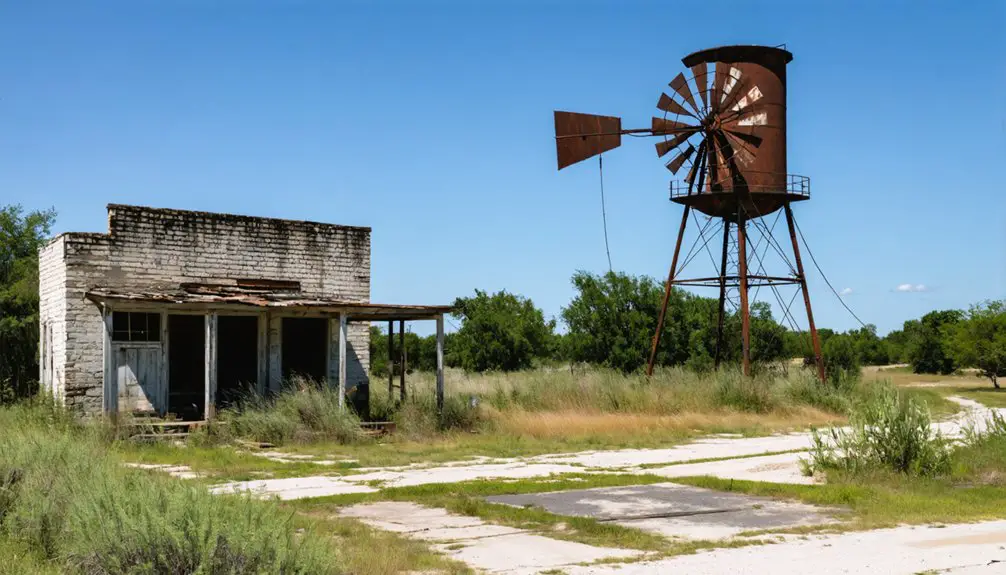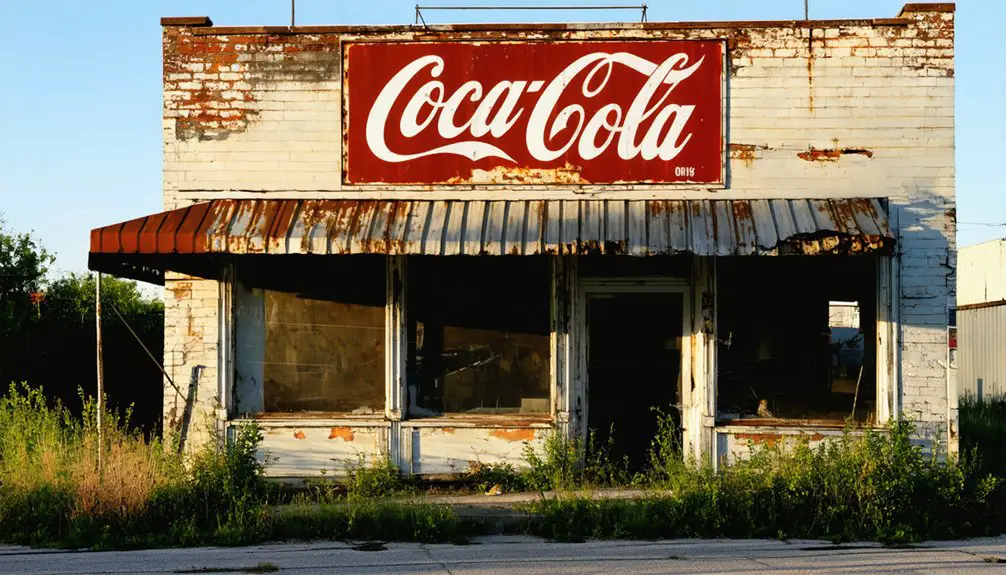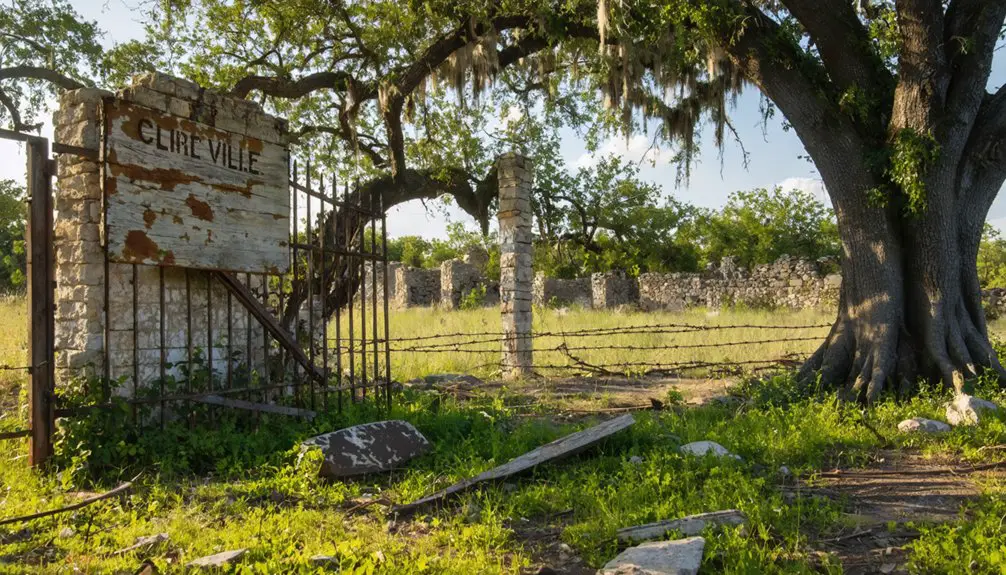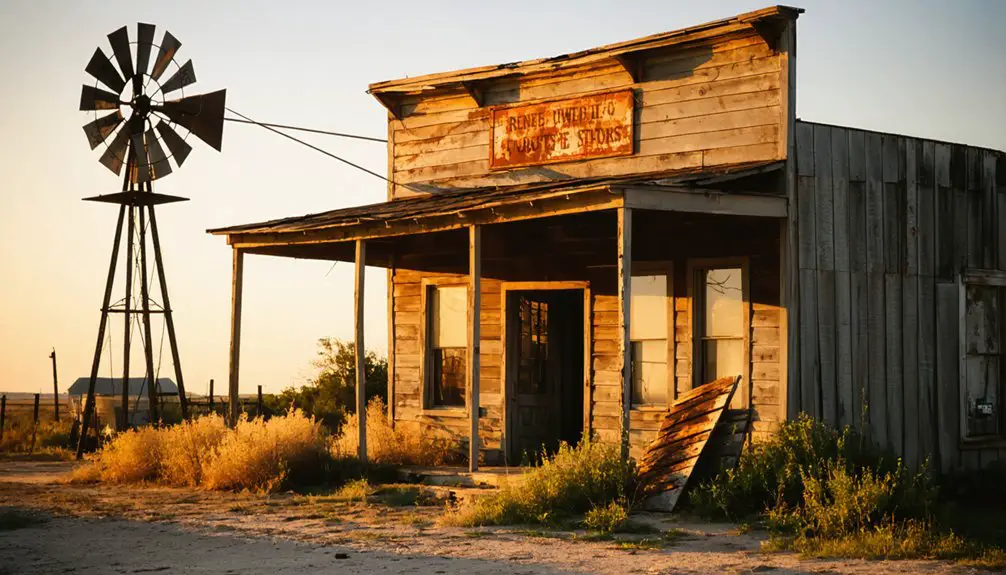You’ll find Clareville at a historic crossroads where U.S. Highway 59 meets Farm-to-Market Roads in the Texas Panhandle. This frontier settlement thrived in the late 1800s as an agricultural hub, anchored by the Hall brothers’ cotton gin and strategic railroad connections. The town’s peak saw bustling stagecoach stops, a schoolhouse, and crucial freight shipping operations. By 2000, only 23 residents remained, with deteriorating structures telling stories of its frontier glory days.
Key Takeaways
- Clareville is a near-abandoned Texas ghost town with only 23 residents reported by 2000, located at crossroads of U.S. Highway 59.
- Originally a frontier settlement, Clareville thrived as an agricultural hub with cotton production before experiencing significant decline in mid-20th century.
- The town’s historic remnants are mostly on private property, requiring advance permission for access and exploration.
- Southern Pacific Railroad infrastructure, including depot and water tanks, played crucial role in town’s peak development during late 19th century.
- Economic issues led to closure of essential services and abandonment of buildings, transforming Clareville from bustling rural hub to ghost town.
Origins and Early Settlement
As pioneers pushed into the Texas Panhandle during the mid-to-late 1800s, Clareville emerged as a small frontier settlement amid the region’s challenging terrain.
You’ll find its origins rooted in the determination of founding families who established themselves along natural waterways and well-worn trails. Much like Plemons Crossing, the settlement provided safe passage across treacherous waterways. These early settlers, many of whom were ranchers and farmers from neighboring states, shaped the initial settlement patterns by building their homes near essential water sources and travel routes. The town remained active until abandoned after disaster, forcing residents to leave their structures behind.
The community’s development followed the typical progression of frontier towns, with residents first establishing basic shelters and gradually adding communal structures.
You can trace Clareville’s early growth through its strategic location, which attracted traders and pioneers seeking new opportunities in the post-Civil War expansion of the American West.
Life in 1870s Clareville
Life in 1870s Clareville reflected the stark realities of Texas frontier existence. You’d find yourself among a small population of hardy pioneers, mostly Anglo-American families with some Mexican neighbors, all working the land to survive.
Like the community of Morris Ranch schoolhouse, local education often took place in simple one-room buildings that served multiple purposes for the settlement.
Your daily routines would revolve around subsistence farming, tending to livestock, and maintaining your basic log or frame home.
Community gatherings provided rare breaks from isolation, often centered around home-based church services or barn raisings.
You’d face constant security threats from Native American raids and livestock thieves, leading families to cluster their homes for protection.
Without formal law enforcement, you’d rely on neighbors for safety.
Trading would be limited to occasional visits from merchants, while you’d produce most necessities at home, from textiles to preserved foods.
Similar to the town of Belle Plain, the settlement experienced significant changes when the railroad bypassed the community.
Agricultural Heritage and Economy
You’ll find Clareville’s agricultural roots firmly planted in family farming operations that initially focused on cotton production in the late 1800s.
The area’s farmers gradually shifted from cotton monoculture to diversified crops, particularly grains for livestock feed, as economic conditions changed and cotton gins relocated to Beeville.
While Clareville’s commercial center faded into ghost town status, the surrounding farmland continued to support multiple progressive farms and ranches, marking the persistence of the area’s agricultural heritage. The Hall brothers’ cotton gin became a significant agricultural hub for the community before operations moved to other towns. Like many of Texas’s 511 ghost towns, Clareville’s story reflects the broader pattern of rural community transformation during periods of economic change.
Farming Family Foundations
The foundation of Clareville’s agricultural heritage rested upon self-sufficient family farms established by Texas Revolution veterans who received bounty lands near present-day Bee County.
The Hefferman family exemplified these pioneering settlers, focusing on both crop cultivation and livestock management around creek bottoms and fertile grasslands. Much like the early Texana settlers during the Revolution period, they played a vital role in establishing agricultural roots in the region.
You’ll find that these early farmers faced formidable agricultural challenges, including Indian and Mexican attacks that disrupted their work patterns and threatened their survival.
They relied heavily on kinship networks for planting, harvesting, and defense. Their isolation meant you’d need ox teams to transport essential supplies from distant boat landings.
Despite primitive farming technologies centered on manual labor and oxen for plowing, these determined families created lasting agricultural communities through generations of shared work and persistence.
Local Crop Production Trends
While cotton dominated much of Texas agriculture in the early 1900s, Bee County and its small community of Clareville developed a more diversified farming economy.
You’d find corn and oats as the area’s principal crops, alongside flax, peanuts, fruits, vegetables, and onions. Farmers practiced crop rotation and soil conservation to maintain land productivity. The Spanish irrigation systems influenced local farming methods, helping establish sustainable water management practices.
The region’s agricultural success expanded when the Agricultural Experimental Station near Beeville opened in 1895, helping you adapt modern farming techniques and improve pest management. The area’s subtropical climate with mild winters and warm summers provided ideal growing conditions.
By the 1920s, you’d see a thriving mix of crops and livestock, with poultry farming emerging as a new venture.
The local soil quality influenced crop choices, and farmers responded by selecting plants that’d thrive in Clareville’s specific conditions, creating a resilient agricultural community.
Transportation Routes and Growth
You’ll find Clareville situated at a key transportation crossroads where U.S. Highway 59 meets Farm-to-Market Roads 796, 323, and 332 in southwestern Bee County.
These routes connected the small community to the larger city of Beeville just 10 miles east, facilitating the movement of agricultural goods and supplies between regional markets.
While the town’s position at these highway intersections provided critical access for local farmers and merchants, Clareville’s population remained modest despite its strategic location, with only 23 residents reported by 2000.
Similar to historic toll roads like the one built by the Albion Plank Road Company in 1846, these transportation routes were vital for connecting rural communities to larger market centers.
Early Highway Connections
During Texas’s frontier era, stagecoach lines established fundamental transportation arteries near Clareville in 1847, connecting major settlements through routes from Houston to Victoria via Egypt and from Lavaca to San Antonio through Victoria, Cuero, and Gonzales.
These early roadways shaped the transportation evolution of the region, with freight and mail services costing $1.00 per 100 lbs.
- First-class mail carriages accommodated ten passengers while serving essential communication needs
- Stage stops like Twenty Mile House provided significant rest points for travelers and animals
- Ox-drawn wagons complemented stagecoach operations, especially for heavy freight transport
You’d find these primitive roads connecting agricultural areas to ferry crossings and river ports, though they faced constant challenges from Native American raids and natural obstacles.
These transportation corridors ultimately determined which settlements would thrive, laying the groundwork for future highway development.
Railroad Access Points
The arrival of the Southern Pacific Railroad in the late 19th century transformed Clareville from a simple stagecoach stop into a bustling railroad access point. The railroad expansion impacts were immediate, as extensive infrastructure emerged including a depot, water tanks, pump houses, and telegraph offices to support operations.
You’ll find that Clareville’s strategic location made it crucial for freight shipping practices, particularly in the livestock industry. The railroad sidings became essential shipping points for goat, sheep, and cattle ranchers from surrounding counties.
Deep wells and pump houses guaranteed steam locomotives had necessary water stops, while salt sheds and loading pens facilitated livestock transport. Despite security challenges from train robberies, Clareville’s connection to larger networks like Southern Pacific made it an integral part of Texas’s transportation corridor, driving settlement and commerce throughout the region.
Stage Coach Stop History
Before becoming a railroad hub, Clareville established itself as an essential stagecoach stop along East Texas’s intricate network of routes connecting Marshall to major Texas-Louisiana destinations like Shreveport and Jefferson.
As part of the region’s stagecoach logistics system, Clareville played a significant role in rural commerce, offering travelers necessary amenities and serving as a communication lifeline.
- Stagecoach operations fostered local business growth through blacksmith shops, general stores, and lodging services.
- The town’s strategic location near water sources made it an ideal rest stop for horse changes and repairs.
- Clareville’s post office became a critical link in the regional mail delivery network.
You’ll find that Clareville’s position along these early transportation routes shaped its initial development, though its prominence would later shift with changing transportation methods.
Peak Years and Community Development
While Clareville’s initial settlement laid the groundwork, its peak years emerged in the late 19th century as agricultural success transformed this small Texas community into a modest but thriving rural hub.
You’d find the town’s community dynamics centered around essential institutions like the local schoolhouse, post office, and Protestant churches, which served as gathering spots for both business and social affairs.
Population trends reflected steady growth, with several dozen to a few hundred residents calling Clareville home during its height.
The economy thrived on cotton farming and cattle ranching, while local merchants provided necessary supplies to both townspeople and surrounding farms.
Timber harvesting from the Hill Country supplemented these primary industries, creating a self-sufficient community typical of rural Texas settlements.
Factors Leading to Decline

Despite Clareville’s promising start, several interconnected factors sparked its eventual decline from the mid-20th century onward. The town’s lack of economic diversification left it vulnerable when critical industries faltered, leading to a devastating chain reaction of business closures and job losses.
Key factors that accelerated Clareville’s downward spiral:
- Closure of essential services, including healthcare facilities and schools, which drove young families away
- Plummeting property values and abandoned homes that discouraged community investment
- Loss of crucial transportation routes that isolated the town from economic opportunities
You’ll find this decline wasn’t unique to Clareville – many Texas High Plains communities faced similar challenges. The exodus of residents to urban areas depleted the tax base, making it impossible to maintain aging infrastructure or attract new businesses.
Notable Landmarks and Structures
Today’s visitors to Clareville will find five key landmarks that tell the story of this once-thriving Texas community.
The historic cemetery stands as the town’s oldest visible landmark, with gravestones dating from 1888 to 1935 that chronicle early settler families. You’ll find the Lutheran church nearby, showcasing typical rural Texas church architecture with its wooden frame and distinctive steeple.
While exploring the grounds, you’ll discover scattered residential foundations and ruins that hint at daily life during Clareville’s peak years.
Roadside historical markers guide your journey through the townsite, providing essential context about its settlement and decline.
The surrounding landscape, now dominated by mesquite trees and native vegetation, has steadily reclaimed the abandoned lots, creating an atmospheric backdrop for cemetery preservation efforts and historical exploration.
Ghost Town Status Today

Today’s Clareville stands as a near-abandoned ghost town with deteriorating structures and minimal to zero permanent residents amid Texas’s rural landscape.
You’ll find most properties vacant and in varying states of disrepair, while public infrastructure remains largely unmaintained with limited utility services.
If you’re planning to visit, be aware that the site functions primarily as a historical point of interest rather than an active community, with no regular services or facilities available to visitors.
Current Site Conditions
As time has steadily eroded its presence, Clareville stands as a quintessential Texas ghost town with no permanent population and minimal remnants of its past.
You’ll find the site largely reclaimed by nature, with deteriorating infrastructure and overgrown vegetation obscuring what’s left of the original settlement. The lack of site preservation efforts has left structures vulnerable to environmental impact, including harsh Texas weather and natural decay.
- Unpaved roads lead to mostly vacant land where buildings once stood
- Any remaining structures are typically roofless and dilapidated
- Surrounding areas have converted to private ranching or agricultural use
If you’re planning to explore Clareville, you’ll need to navigate unmarked paths and expect few preserved features, as the town continues its slow fade into the Texas landscape.
Remaining Historic Features
The remaining historic features of Clareville paint a portrait of industrial decline, with scattered mining equipment ruins near windmills serving as the most prominent remnants of its operational past.
You’ll find several architectural remnants scattered throughout the site, though many are fenced off and marked with no trespassing signs. One relatively intact building stands out among the deteriorated structures, hinting at more recent occupation.
The site’s historical significance is preserved through various markers that help tell Clareville’s story. While many original structures have succumbed to time and the elements, you can still spot foundations and partial walls amid the natural vegetation.
Mining equipment, though weathered, provides tangible evidence of the town’s industrial heritage, while springs and local topography continue to shape the preservation of these remaining features.
Visitor Access Information
While the historic remnants of Clareville stand as silent witnesses to its past, accessing this ghost town requires careful planning and consideration of several restrictions.
You’ll need to navigate various access challenges, as most of the site lies on private property requiring advance permission. Local visitor guidelines emphasize safety precautions due to deteriorating structures and limited emergency services.
Key considerations before your visit:
- Research property ownership and obtain necessary permissions to avoid trespassing
- Prepare for minimal infrastructure – no amenities, cell service, or maintained roads
- Bring essential supplies including water, navigation tools, and safety equipment
Weather conditions can affect accessibility, particularly during rain.
You’ll find no official visitor center or guided tours, so self-reliance is vital. Remember that removal of artifacts is prohibited, helping preserve this piece of Texas history.
Historical Maps and Documentation

Through extensive cartographic records, researchers have access to nine detailed historic maps that document Clareville’s development and decline in Bee County, Texas.
These maps showcase the town’s historical significance through clear cartographic evidence of old homesites, trails, and community landmarks.
You’ll find these maps particularly valuable for exploring Clareville’s ghost town boundaries and former infrastructure. They reveal the positioning of key buildings, abandoned roads, and environmental features that influenced settlement patterns.
For metal detecting enthusiasts and history buffs, specialized maps on platforms like Pastmaps highlight promising artifact locations within documented activity zones.
The maps serve as essential tools for heritage tourism, research expeditions, and preservation efforts, helping you understand how this once-thriving community evolved within Bee County’s landscape.
Legacy in Texas History
Established in 1874 by Missouri veteran Henry T. Clare, Clareville stands as a symbol of Texas frontier resilience. You’ll find this ghost town’s legacy deeply woven into the fabric of Texas history, marked by military conflicts and community resilience during an era of territorial defense.
- The town exemplifies the determination of early settlers who faced threats from Native Americans and Mexican troops while building self-sufficient agricultural communities.
- Clareville’s strategic location near modern Highway 59 reflects the importance of transportation routes in 19th-century Texas settlement patterns.
- The Clare family’s participation in the Mexican War and Texas Revolution connects the town to broader military struggles that shaped the state.
Though now largely abandoned, Clareville’s story captures the spirit of freedom and independence that characterized Texas frontier settlements.
Frequently Asked Questions
Are There Any Documented Paranormal Activities or Ghost Stories From Clareville?
You won’t find documented haunted tales or ghost sightings specific to Clareville. Unlike nearby Helena’s well-recorded paranormal activity, there’s no verified evidence of supernatural events in this Bee County ghost town.
What Happened to the Original Residents’ Descendants and Where Did They Relocate?
Like seeds scattered by prairie winds, you’ll find descendant stories leading to Beeville, just ten miles east, where most families transplanted themselves seeking better opportunities and economic stability.
Is Metal Detecting or Artifact Collecting Allowed on Clareville’s Former Grounds?
You’ll need explicit landowner permission due to metal detecting regulations and artifact ownership laws. Since Clareville’s mainly private property, you can’t freely collect without risking legal consequences.
Were There Any Notable Crimes or Significant Lawlessness in Clareville?
Like a still pond untouched by ripples, you’ll find no documented crime history or significant lawlessness in the settlement. Records don’t show any notable law enforcement presence or criminal activity.
Can Visitors Access Private Property Areas Where Clareville’s Structures Once Stood?
You can’t freely access Clareville’s remaining structures due to strict private property restrictions. You’ll need explicit landowner permission to visit any historical sites within these privately-owned boundaries.
References
- https://texashighways.com/travel-news/four-texas-ghost-towns/
- https://www.youtube.com/watch?v=phjUE19A8HM
- https://pastmaps.com/explore/us/texas/bee-county/clareville/metal-detecting
- https://www.allacrosstexas.com/texas-small-town.php?city=Clareville
- https://pastmaps.com/explore/us/texas/bee-county/clareville/hiking-exploration
- https://en.wikipedia.org/wiki/List_of_ghost_towns_in_Texas
- https://www.texasescapes.com/TOWNS/Texas-Ghost-Towns-8-South-Texas.htm
- https://www.texasescapes.com/SouthTexasTowns/Clareville-Texas.htm
- https://www.ghosttowns.com/states/tx/clareville.html
- https://mix941kmxj.com/the-strange-sad-story-of-a-texas-ghost-town-youll-never-visit/



